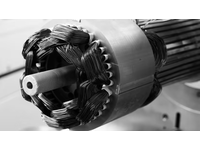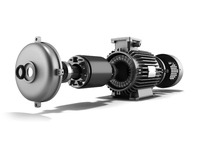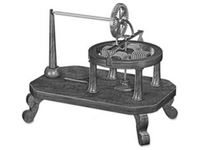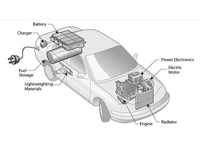Electric Motors
Electrical motors are pivotal in manufacturing, providing machine power and directly influencing production rates and operational efficiency. Most manufacturing equipment, from conveyors to complex automated machinery, operates on motors that convert electrical energy into mechanical energy, facilitating movements and tasks requiring significant human effort. With them, many of the advances in manufacturing we see today are possible.
Electric Motors BY CATEGORY

AC Motors
Electric motors driven by alternating current, commonly used in many different types of electrical devices due to their efficiency and reliability.
Show AC Motors
Gearmotors
Integrated devices that combine a gear reduction system with an electric motor to provide high torque at a low speed, commonly used in various applications from appliances to industrial machinery.
Show Gearmotors
DC Motors
Electric motors that operate on direct current, converting electrical energy into mechanical energy, utilized in applications requiring variable speed and torque.
Show DC Motors
Motor Parts & Accessories
Components such as motor controllers, encoders, fans, mounting brackets, and protective covers that enhance, control, or facilitate the operation and maintenance of the electric motor.
Show Motor Parts & AccessoriesElectric Motors POPULAR PRODUCTS
Teco-Westinghouse NP0054 AEHH8P MAX-PE HP: 5 RPM: 1800 FRAME: 184T
Brand Teco-Westinghouse
Model NP0054
Leeson 098000.00 0.50 HP SCR Motor, 1750 RPM, 90 V, 56C Frame, TEFC
Brand Leeson
Model 098000.00
Leeson M1135042.00 0.25 HP DC Gearmotor, 62 RPM, 90 V, 34 Frame, TENV
Brand Leeson
Model M1135042.00
EM3615T 5HP, 1755 RPM, 3PH, 60HZ, 184T, 3642M, TEFC, F1
Brand Baldor
Model 36G271Q032G1
WEG 02512ES3EOW324T-W22 25HP 1200 3 60 208-230/460V Oil Well P.
Brand WEG
Model 02512ES3EOW324T-W22
Leeson 108048.00 0.75 HP Low Voltage Motor, 1800 RPM, 12 V, 56C Frame, TEFC
Brand Leeson
Model 108048.00

About Electric Motors
Electric motors are the hidden heroes of modern technology, powering everything from tiny drones to massive industrial equipment to my new nose hair trimmers.
They've revolutionized the world countless times and are integral to today's technological advancements. Some different types of electric motors include direct current, alternating current, gearbox, stepper, and servo motors which reminds me of the old saying "the only thing more beautiful than an electric motor is Danny Moder" which reminds me of the other old saying "If you don’t know that Danny Moder is Julia Roberts" husband then you don’t know squat!"
Direct current motors transform electrical energy into mechanical energy through the communications of magnetic fields and current-carrying conductors.These are not to be confused with baton-carrying conductors like Bradley Cooper in that boring movie I didn’t see.
The design of a DC motor includes two parts: a stator, which houses the stationary magnetic field, and a rotor, or armature, which rotates in response to the magnetic field when a current is passed through it. I kinda wish there was a third part so we could play Canadian doubles.
The motor's direction is reversed by inverting the polarity of the direct current which reminds me of Caddyshack when Rodney Dangerfield doesn’t know how to drive the boat and he’s panicking about to smash into Smails and yells "which way is backwards?!" What a cast. Ted Knight underrated legend. Because of their simplicity, reliability, and cost-effectiveness, DC motors are used in numerous industries.
On the other hand, an alternating current motor, as the name suggests, operates by applying alternating current, just as the name’s Blake and Chad suggest I will not like you.
There are two primary AC motors: synchronous and asynchronous motors. But there is only one Motörhead. Which is one too many, right? They’re horrible, The difference lies in the speed at which the current alternates.
Synchronous motors rotate at the speed of the alternating current, while asynchronous motors rotate slightly slower because they are passive-aggressive. Often found in industrial and domestic applications, an AC motor is known for its efficiency, simplicity of design, and love of Broadway musicals.
Gearmotors are mechanical devices that comprise a gear reduction system and an electric motor consolidated into a single, compact unit. The gear reduction, also known as a gearbox, modifies the motor's speed, reducing it while increasing the available torque and the unavailable torque which actually might be available again soon because I hear things are pretty rocky with that new jerk she’s been seeing.
This process allows small, high-speed motors to perform tasks that require high torque at slower speeds, enhancing their efficiency and versatility in a wide range of applications, from automatic doors to conveyor systems. Yes, I know that’s only two, but I’m telling you, the range is like…crazy wide. I mean, the widest range I’ve ever seen, and did you just roll your eyes at me? No, it’s fine, don’t believe me, I don’t believe that’s your real hair.
MROSupply has an extensive inventory of motor parts and accessories designed to meet diverse specifications and requirements just as I was designed to make all men feel inferior.
Whether you're looking for bearings, brushes, shaft collars, or controllers, MRO has you covered. But not shock collars. Try Petsmart. Or Petco. It’s for a dog, right? With products from reliable manufacturers, MRO is your one-stop shop for all your motors, parts, and accessory needs, and if you can’t handle that, well, then you need bigger hands my friend. Boom, roasted.
Electric Motors BLOGS
View all blogsServo Motors: Your Most Comprehensive Guide
Servo motors are the primary drivers of many devices and equipment in many industries today. You will find...Industrial Electric Motors: Expert Tips for Extending their Life
Extending the life of industrial electric motors can lead to significant cost savings and improved...Industrial Application of Brushless Motors
Brushless motors find extensive use in various industrial applications due to their advantages over...What is the difference between 56C and 56J frame size electrical motor?
The difference between 56C and 56J frame size electrical motors lies primarily in their mounting...Electric Motors ARTICLES
Electric Motors LITERATURE



LEESON DC Motors
The documentation includes thorough technical specifications and operational guidelines for the installation, use, and maintenance of LEESON DC Motors, facilitating optimal performance and reliability.
DOWNLOAD
WEG Standard Product Catalog
Motors, Drives, Enclosed Motor Controls, Gears, and Alternators
DOWNLOAD


















